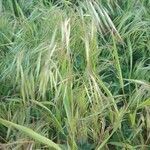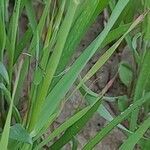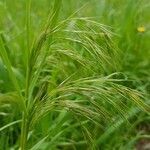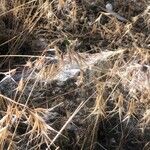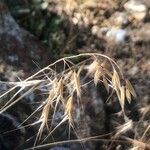Annual. Culms erect, 20–60 cm tall, 3-or 4-noded. Leaf sheaths pubescent; leaf blades 5–20 cm, 2–4 mm wide, pubescent; ligule 1.5–2 mm. Panicle spreading, 8–15 cm, secund; branches 3–5 at lower nodes, slender, mostly curved, scabrid, pubescent, each bearing 1–8 slightly nodding spikelets. Spikelets 10–35(–50) mm; florets 4–8; rachilla internodes 2–3 mm; glumes narrowly lanceolate, margins membranous, lower glume 8–15 mm, 1–3-veined, upper glume 11–17 mm, 3–7-veined, apex acute, obtuse, or shortly aristiform; lemmas 9–22 mm, 1–1.5 mm wide in side view, 5–7-veined, scabrid or pubescent, margins thinly membranous, shiny, apex acuminate, acute, or obtuse, 2-toothed, awned from sinus, awn 12–25(–40) mm, slender, straight; palea shorter than or subequal to lemma, keels ciliate. Stamens 3; anthers 0.5–2 mm. Fl. and fr. May–Sep.
Annual, caespitose. Culms 12–42 cm high. Leaves: basal sheaths densely pubescent and pilose; blade 4.5–11 cm long, 2–4 mm wide, pubescent to pilose. Panicles nodding, open, 4–11 cm long; primary branches spreading or divaricate. Spikelets erect or pendulous, cuneate, 17–20.5 mm long, with 3 or 4 bisexual florets; pedicel 3–14 mm long. Glumes unequal, keeled, with midnerve scabrous to puberulous and intercostal regions puberulous to pilose; lower glume 6.5–7.6 mm long, 1-nerved; upper glume 9–10 mm long, 3-nerved. Callus blunt, glabrous. Basal lemma laterally compressed, 11.7–12.8 mm long, ±keeled, 3–5-nerved, scabrous to pilose; awn dorsal, arising 2.5–3 mm below lemma tip, 11–12 mm long, straight, entered by 3 nerves. Palea slightly shorter than lemma, glabrous. Anthers 0.6–0.7 mm long.
Annual 2–7 dm; sheaths and blades soft-hairy, the latter 2–4 mm wide; ligule 1–2.5(–4) mm; infl 1–2 dm, often nodding, repeatedly but rather openly branched, bearing somewhat crowded, mostly drooping, 3–8-fld spikelets to 2(–3.5) cm on slender pedicels; glumes subulate, the first 5–7 mm, 1-veined, the second 8–11 mm, 3-veined; lemmas narrowly lanceolate, 8–12(–15) mm, evidently hairy or seldom glabrous, 1–1.5 mm wide in side-view, 5–7-veined, acuminate into slender scarious teeth 1–3 mm; awns (7–)10–17 mm; palea shorter than the lemma; anthers 0.5–0.7 mm; 2n=14. Native of Europe, now a common weed nearly throughout the U.S., esp. westward.
Tufted annual 100-250 mm high. Leaf blade 60-100 x 2-4 mm, hairy. Inflorescence open, drooping, spikelets ± secund; lower pedicels and branches with ± four spikelets; branches and pedicels twisted or curved, flexuous. Spikelet 8-15(20) x 2-4 mm, moderately laterally compressed, spikelet hairy to glabrous; lower glume 1-nerved; upper glume 7-12 mm long; 3-5-nerved; lemma 8-13 mm long, rounded on back, margins hyaline, bifid; awn 8-20 mm long, straight, arising well below apex; palea ciliate on keels, hairy between keels; callus scar circular, minutely hairy; anthers 0.5-1.0 mm long.
An annual grass. It is erect and grows 60 cm high. The leaves are near the base and form a sheath. They are narrow and sword shaped. The leaf blades are 18 cm long. The flower panicle is 18 cm long and can be loose or dense. The spikelets are narrowly wedge shaped and fragile.
